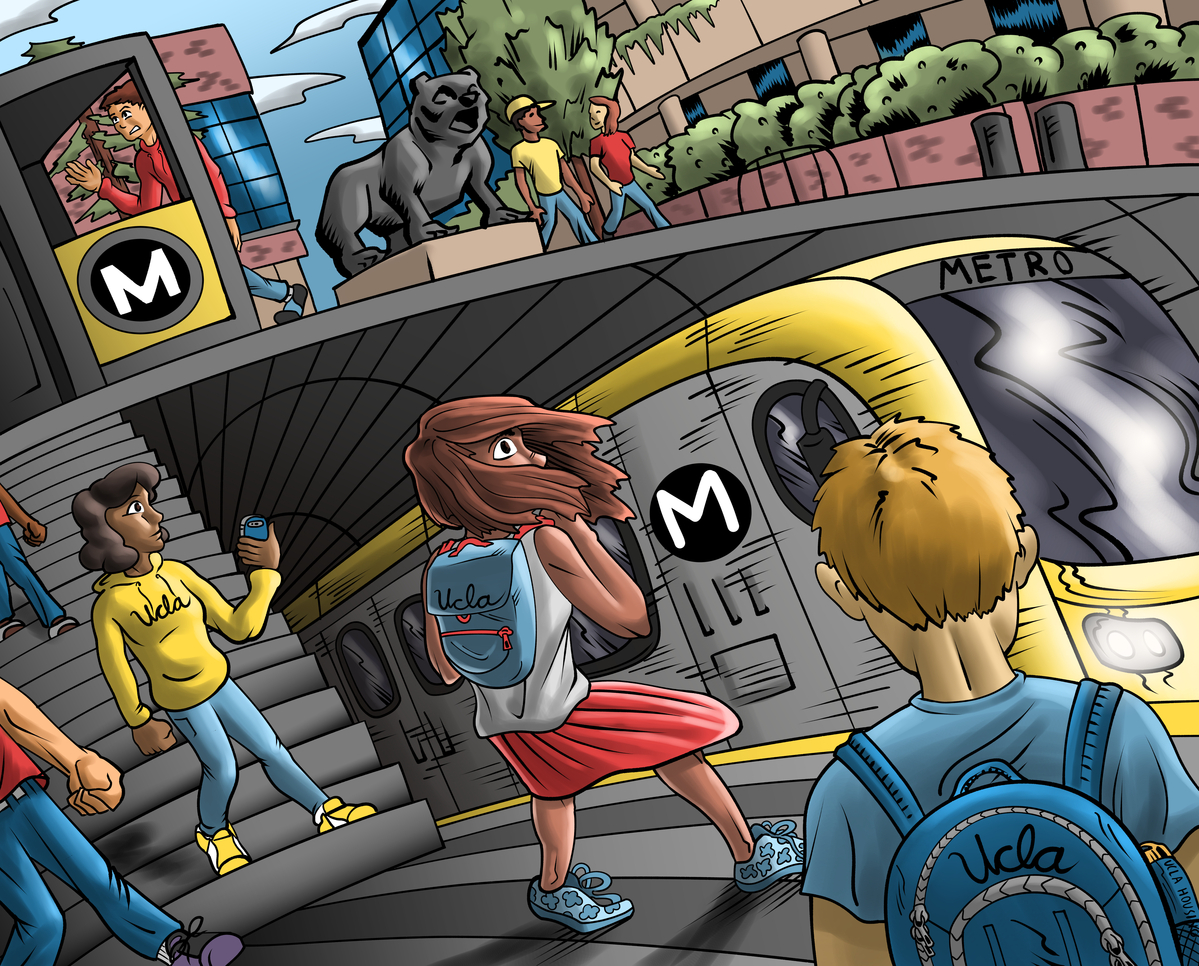Planned metro line at UCLA could make commuting easier for students

(Cody Wilson/Daily Bruin)
By Elizabeth Hanczor
Jan. 9, 2020 10:08 p.m.
It’s not hard to believe a grid of high-speed trains designed to transport people safely, efficiently and inexpensively would be so popular.
What’s hard to believe is that Los Angeles is just now catching onto the ways of Manhattan, Boston, Philadelphia, Paris, Chicago, London and San Francisco by completing 28 new metro projects across the city.
Los Angeles Metro recently announced a plan to revamp its existing train system with a series of new extensions and lines. The operation has been coined “Twenty-Eight by ’28” in the hopes that these trains will be funded and installed to meet expectations of growing tourism before the torch is lit for the Summer Olympics.
Luckily for Bruins, UCLA is one of those 28. In a feasibility report released in November, the Luskin turnaround is listed as a location for a stop to be installed. It’s a welcome change for students, given that the closest existing stop is nearly 13 miles away.
This new station would be part of the Sepulveda Transit Corridor Project, a rail transit service that would quickly take people through the Sepulveda Pass from the San Fernando Valley to the Westside. Simply put, UCLA would be thrust into an impressive feat of public transit.
However, Angelenos and city officials remain baffled over whether this system will be popular among residents and students.
The answer lies in Westwood.
Both the city’s U-Pass program and the university need to find a way to make it completely free or, at the least, integrate fees into students‘ tuitions to make it an option for every Bruin. By requiring UCLA students to pay the minute fee as a part of their tuitions, they will be more incentivized to use the public transit that’s already included in their yearly costs. Shifting toward a pro-public transit mindset is cost-efficient, environmentally friendly and inclusive of commuter students.
UCLA wouldn’t be the first to take progressive measures, but at this rate it might be the last.
The Chicago Transit Authority’s U-Pass program, similar to that of Los Angeles, lowers the cost of student travel significantly. However, schools like Loyola University Chicago and The University of Chicago dump the remaining fee into students’ tuitions. As a result, more kids are able to maneuver the city without needing to pay for gas, parking, cabs or ride-hailing services.
Los Angeles is over twice the size of Chicago, meaning students have twice the amount of land to cover in their four years.
And although it would be beneficial for explorers, the project’s real impact would be on commuter students.
Yassi Badri, a graduate of UCLA, said complications from her commute could have been the difference between passing and failing a final she planned and prepared for.
“My commute was normally around 25 to 30 minutes, but in this situation it was 45 to 55 minutes,” Badri said. “If I was walking I most likely would not have come into the same surprises of peoples’ cars breaking down or just simply being bad drivers in the rain.”
While Badri was fortunate to have a benevolent professor, not every student is that lucky. And an efficient public transit system could help.
Undoubtedly, the daily LA commute is grueling for many students. Tess Cruickshank, a fourth-year anthropology student, lives only 12 miles from campus – but her drive can reach over two hours.
For students like her, being able to easily go back and forth would be game-changing.
“It’s so hard making friends,” Cruickshank said. “People say, ‘Oh, you’re a commuter student, you don’t live at UCLA, you don’t live in Westwood,’ and immediately that conversation is pretty much over.”
This isolation is part of everyday life for many commuter students. But a new metro system could provide them with a method of transportation that would grant them more time on campus.
And once that door opens, it’s not just academic and social opportunities that increase.
Sean Lashkari, a third-year statistics student, said that his current method of transportation has prevented him from participating in campus activities.
“I would have done IM sports,” Lashkari said. “Most of them meet late which is when I would have needed to go home.”
Some may argue that requiring students to pay a fee for something they might not use is absurd and the university should simply maintain the discounted U-Pass system that is already implemented.
Then again, UCLA has a bit of an Uber addiction.
UCLA takes about 11,000 Uber and Lyft rides a week from one part of campus to another. A recent report pointed to an imbalance between students’ disdain for automobiles and their love for quick rides. But with that convenience comes greenhouse emissions that could otherwise be avoided with an on-campus stop.
And while this added tuition fee won’t be guaranteed to cure students’ tendencies to catch a Lyft to class, it will lessen the footprint of commuters, interns and workers that have been getting to and from campus.
The fewer people we have on the road, the better the health of our planet will be. Additionally, students will finally be able to flow in and out of campus without any undue harm to the environment. A consolidated metro system will decongest roads and get people into efficient and cost-effective trains to their final destinations.
It’s time for Los Angeles to put its money where its mouth is. A small fee for a year of free public transit is worth it, even if you aren’t the one on the train.
Changes as large as these take time.
The good news is, Los Angeles has eight years.

